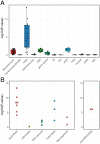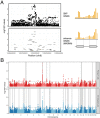Identifying enhancer properties associated with genetic risk for complex traits using regulome-wide association studies
- PMID: 36070311
- PMCID: PMC9484640
- DOI: 10.1371/journal.pcbi.1010430
Identifying enhancer properties associated with genetic risk for complex traits using regulome-wide association studies
Abstract
Genetic risk for complex traits is strongly enriched in non-coding genomic regions involved in gene regulation, especially enhancers. However, we lack adequate tools to connect the characteristics of these disruptions to genetic risk. Here, we propose RWAS (Regulome Wide Association Study), a new application of the MAGMA software package to identify the characteristics of enhancers that contribute to genetic risk for disease. RWAS involves three steps: (i) assign genotyped SNPs to cell type- or tissue-specific regulatory features (e.g., enhancers); (ii) test associations of each regulatory feature with a trait of interest for which genome-wide association study (GWAS) summary statistics are available; (iii) perform enhancer-set enrichment analyses to identify quantitative or categorical features of regulatory elements that are associated with the trait. These steps are implemented as a novel application of MAGMA, a tool originally developed for gene-based GWAS analyses. Applying RWAS to interrogate genetic risk for schizophrenia, we discovered a class of risk-associated AT-rich enhancers that are active in the developing brain and harbor binding sites for multiple transcription factors with neurodevelopmental functions. RWAS utilizes open-source software, and we provide a comprehensive collection of annotations for tissue-specific enhancer locations and features, including their evolutionary conservation, AT content, and co-localization with binding sites for hundreds of TFs. RWAS will enable researchers to characterize properties of regulatory elements associated with any trait of interest for which GWAS summary statistics are available.
Conflict of interest statement
The authors have declared that no competing interests exist.
Figures






References
-
- Davidson EH. Gene Regulatory Networks for Development. The Regulatory Genome. Elsevier; 2006. pp. 125–185.
Publication types
MeSH terms
Substances
Grants and funding
LinkOut - more resources
Full Text Sources

